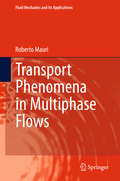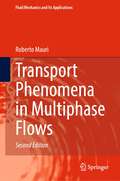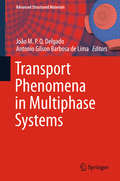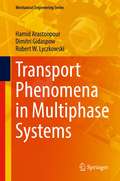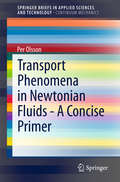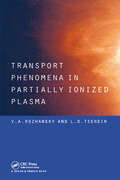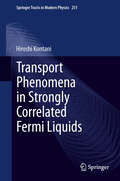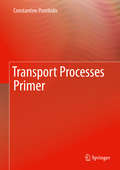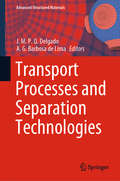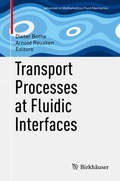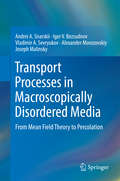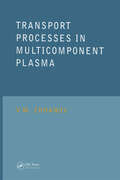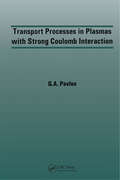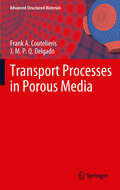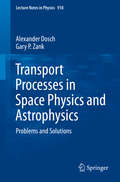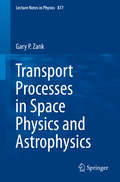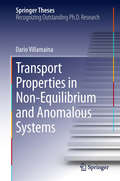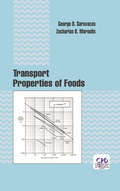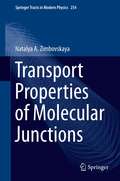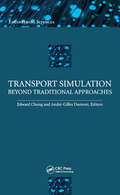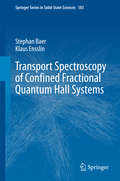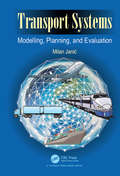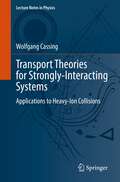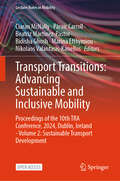- Table View
- List View
Transport Phenomena in Multiphase Flows
by Roberto MauriThis textbook provides a thorough presentation of the phenomena related to the transport of mass, momentum and energy. It lays all the basic physical principles, then for the more advanced readers, it offers an in-depth treatment with advanced mathematical derivations and ends with some useful applications of the models and equations in specific settings. The important idea behind the book is to unify all types of transport phenomena, describing them within a common framework in terms of cause and effect, respectively represented by the driving force and the flux of the transported quantity. The approach and presentation are original in that the book starts with a general description of transport processes, providing the macroscopic balance relations of fluid dynamics and heat and mass transfer, before diving into the mathematical realm of continuum mechanics to derive the microscopic governing equations at the microscopic level. The book is a modular teaching tool and can be used either for an introductory or for an advanced graduate course. The last 6 chapters will be of interest to more advanced researchers who might be interested in particular applications in physics, mechanical engineering or biomedical engineering. All chapters are complemented with exercises that are essential to complete the learning process.
Transport Phenomena in Multiphase Flows (Fluid Mechanics and Its Applications #112)
by Roberto MauriThis textbook provides a thorough presentation of the phenomena related to the transport of mass (with and without electric charge), momentum and energy. It lays all the basic physical principles, and then for the more advanced readers, it offers an in-depth treatment with advanced mathematical derivations and ends with some useful applications of the models and equations in specific settings. The important idea behind the book is to unify all types of transport phenomena, describing them within a common framework in terms of cause and effect, respectively, represented by the driving force and the flux of the transported quantity. The approach and presentation are original in that the book starts with a general description of transport processes, providing the macroscopic balance relations of fluid dynamics and heat and mass transfer, before diving into the mathematical realm of continuum mechanics to derive the microscopic governing equations at the microscopic level. The book is a modular teaching tool and is used either for an introductory or for an advanced graduate course. The last six chapters are of interest to more advanced researchers who might be interested in applications in physics, mechanical engineering or biomedical engineering. In particular, this second edition of the book includes two chapters about electric migration, that is the transport of mass that takes place in a mixture under the action of electro-magnetic fields. Electric migration finds many applications in the modeling of energy storage devices, such as batteries and fuel cells. All chapters are complemented with solved exercises that are essential to complete the learning process.
Transport Phenomena in Multiphase Systems (Advanced Structured Materials #93)
by João M.P.Q. Delgado Antonio Gilson Barbosa de LimaThis book presents a collection of recent contributions in the field of transport phenomena in multiphase systems, namely, heat and mass transfer. It discusses various topics related to the transport phenomenon in engineering (including state-of-the-art, theory and applications) and introduces some of the most important theoretical advances, computational developments and technological applications in multiphase systems domain, providing a self-contained key reference that is appealing to scientists, researchers and engineers alike. At the same time, these topics are relevant to a variety of scientific and engineering disciplines, such as chemical, civil, agricultural, and mechanical engineering.
Transport Phenomena in Multiphase Systems (Mechanical Engineering Series)
by Robert W. Lyczkowski Hamid Arastoopour Dimitri GidaspowThis volume fills the need for a textbook presenting basic governing and constitutive equations, followed by several engineering problems on multiphase flow and transport that are not provided in current advanced texts, monographs, or handbooks. The unique emphasis of this book is on the sound formulation of the basic equations describing multiphase transport and how they can be used to design processes in selected industrially important fields. The clear underlying mathematical and physical bases of the interdisciplinary description of multiphase flow and transport are the main themes, along with advances in the kinetic theory for particle flow systems. The book may be used as an upper-level undergraduate or graduate textbook, as a reference by professionals in the design of processes that deal with a variety of multiphase systems, and by practitioners and experts in multiphase science in the area of computational fluid dynamics (CFD) at U.S. national laboratories, international universities, research laboratories and institutions, and in the chemical, pharmaceutical, and petroleum industries. Distinct from other books on multiphase flow, this volume shows clearly how the basic multiphase equations can be used in the design and scale-up of multiphase processes. The authors represent a combination of nearly two centuries of experience and innovative application of multiphase transport representing hundreds of publications and several books. This book serves to encapsulate the essence of their wisdom and insight, and:
Transport Phenomena in Newtonian Fluids - a Concise Primer
by Per OlssonThis short primer provides a concise and tutorial-style introduction to transport phenomena in Newtonian fluids , in particular the transport of mass, energy and momentum. The reader will find detailed derivations of the transport equations for these phenomena, as well as selected analytical solutions to the transport equations in some simple geometries. After a brief introduction to the basic mathematics used in the text, Chapter 2, which deals with momentum transport, presents a derivation of the Navier-Stokes-Duhem equation describing the basic flow in a Newtonian fluid. Also provided at this stage are the derivations of the Bernoulli equation, the pressure equation and the wave equation for sound waves. The boundary layer, turbulent flow and flow separation are briefly reviewed. Chapter 3, which addresses energy transport caused by thermal conduction and convection, examines a derivation of the heat transport equation. Finally, Chapter 4, which focuses on mass transport caused by diffusion and convection, discusses a derivation of the mass transport equation.
Transport Phenomena in Partially Ionized Plasma
by V.A. Rozhansky L.D. TsendinTransport phenomena in plasmas are the relatively slow processes of particle momentum and energy transport systems in a state of mechanical equilibrium. In contrast to neutral gases, these phenomena in plasmas are greatly influenced by self-consistent fields, in particular electric fields. These can produce particle and energy fluxes, in addition t
Transport Phenomena in Strongly Correlated Fermi Liquids
by Hiroshi KontaniIn conventional metals, various transport coefficients are scaled according to the quasiparticle relaxation time, \tau, which implies that the relaxation time approximation (RTA) holds well. However, such a simple scaling does not hold in many strongly correlated electron systems, reflecting their unique electronic states. The most famous example would be cuprate high-Tc superconductors (HTSCs), where almost all the transport coefficients exhibit a significant deviation from the RTA results. To better understand the origin of this discrepancy, we develop a method for calculating various transport coefficients beyond the RTA by employing field theoretical techniques. Near the magnetic quantum critical point, the current vertex correction (CVC), which describes the electron-electron scattering beyond the relaxation time approximation, gives rise to various anomalous transport phenomena. We explain anomalous transport phenomena in cuprate HTSCs and other metals near their magnetic or orbital quantum critical point using a uniform approach. We also discuss spin related transport phenomena in strongly correlated systems. In many d- and f-electron systems, the spin current induced by the spin Hall effect is considerably greater because of the orbital degrees of freedom. This fact attracts much attention due to its potential application in spintronics. We discuss various novel charge, spin and heat transport phenomena in strongly correlated metals.
Transport Processes Primer
by Constantine PozrikidisIn this concise yet comprehensive book, the author discusses the principles of mass, momentum, and energy transport, and derives balance equations for single-component fluids and multicomponent mixtures based on the direct application of natural laws and principles of thermodynamics. Transport equations over control volumes are formulated with reference to the Reynolds transport equation, thereby circumventing the need for ad-hoc balances for open systems that are best justified in hindsight. Notable features with regard to mass transport include the interpretation of diffusion in mixtures in terms of species parcel motion and separation, the introduction of Fick’s and fractional diffusion laws with reference to random molecular excursions, a detailed account of species and mixture kinematics and dynamics, and the discussion of partial stresses, energies, and entropies of individual mixture components. Key features of this book include:• The governing equations are derived from first principles based on the application of natural laws and principles of thermodynamics• Balances over control volumes are derived from rigorous equations governing material parcel property evolution• Fick’s law, a fractional diffusion law, and other diffusion laws are discussed with reference to random walks• A detailed account of species and mixture kinematics and dynamics is presented for binary and multicomponent solutions• A tabulated summary of transport equations is presented in differential and integral forms, and an overview of classical thermodynamics is given in an appendix for a self-contained discourseC. Pozrikidis has taught at the University of California and the University of Massachusetts. He is the author of several books on theoretical and computational topics in science and engineering, applied mathematics, scientific computing, and computer science.
Transport Processes and Separation Process Principles (International Series in the Physical and Chemical Engineering Sciences)
by Christie Geankoplis Allen Hersel Daniel LepekTransport Processes and Separation Process Principles, Fifth Edition, offers a unified and up-to-date treatment of momentum, heat, and mass transfer and separations processes. This edition–reorganized and modularized for better readability and to align with modern chemical engineering curricula–covers both fundamental principles and practical applications, and is a key resource for chemical engineering students and professionals alike.
Transport Processes and Separation Technologies (Advanced Structured Materials #133)
by J. M. P. Q. Delgado A. G. Barbosa de LimaThis book presents recent research in the field of transport phenomena in porous materials, including heat and mass transfer, drying and adsorption. Covering a comprehensive range of topics related to the transport phenomenon in engineering (including state-of-the-art, theory and technological applications), it discusses some of the most important theoretical advances, computational developments and applications in porous materials domain. Providing an update on the current state of knowledge, this self-contained reference resource will appeal to scientists, researchers and engineers in a variety of disciplines, such as chemical, civil, agricultural and mechanical engineering.
Transport Processes at Fluidic Interfaces
by Dieter Bothe Arnold ReuskenThere are several physico-chemical processes that determine the behavior of multiphase fluid systems - e. g. , the fluid dynamics in the different phases and the dynamics of the interface(s), mass transport between the fluids, adsorption effects at the interface, and transport of surfactants on the interface - and result in heterogeneous interface properties. In general, these processes are strongly coupled and local properties of the interface play a crucial role. A thorough understanding of the behavior of such complex flow problems must be based on physically sound mathematical models, which especially account for the local processes at the interface. This book presents recent findings on the rigorous derivation and mathematical analysis of such models and on the development of numerical methods for direct numerical simulations. Validation results are based on specifically designed experiments using high-resolution experimental techniques. A special feature of this book is its focus on an interdisciplinary research approach combining Applied Analysis, Numerical Mathematics, Interface Physics and Chemistry, as well as relevant research areas in the Engineering Sciences. The contributions originated from the joint interdisciplinary research projects in the DFG Priority Programme SPP 1506 "Transport Processes at Fluidic Interfaces. "
Transport Processes in Macroscopically Disordered Media
by Andrei A. Snarskii Igor V. Bezsudnov Vladimir A. Sevryukov Alexander Morozovskiy Joseph MalinskyThis book reflects on recent advances in the understanding of percolation systems to present a wide range of transport phenomena in inhomogeneous disordered systems. Further developments in the theory of macroscopically inhomogeneous media are also addressed. These developments include galvano-electric, thermoelectric, elastic properties, 1/f noise and higher current momenta, Anderson localization, and harmonic generation in composites in the vicinity of the percolation threshold. The book describes how one can find effective characteristics, such as conductivity, dielectric permittivity, magnetic permeability, with knowledge of the distribution of different components constituting an inhomogeneous medium. Considered are a wide range of recent studies dedicated to the elucidation of physical properties of macroscopically disordered systems. Aimed at researchers and advanced students, it contains a straightforward set of useful tools which will allow the reader to derive the basic physical properties of complicated systems together with their corresponding qualitative characteristics and functional dependencies.
Transport Processes in Multicomponent Plasma
by V.M. ZhdanovTransport Processes in Multicomponent Plasma is a revised and updated version of the original Russian edition. The book examines transport phenomena in multicomponent plasma and looks at important issues such as partially ionized gases, molecular gas mixtures and methods of calculating kinetic coefficients. It makes a logical progression from simpl
Transport Processes in Plasmas with Strong Coulomb Interactions
by G.A. PavlovThe first part of this monograph presents theoretical analysis of the thermophysical properties of strongly coupled coulomb systems. A new model is then developed, making it possible to calculate the full set of low temperature, multicomponent, nonideal plasma transport coefficients, based on the kinetic coefficients of strongly coupled coulomb sys
Transport Processes in Porous Media
by J.M.P.Q. Delgado Frank A. CoutelierisThe subject of this book is to study the porous media and the transport processes occur there. As a first step, the authors discuss several techniques for artificial representation of porous. Afterwards, they describe the single and multi phase flows in simplistic and complex porous structures in terms of macroscopic and microscopic equations as well as of their analytical and numerical solutions. Furthermore, macroscopic quantities such as permeability are introduced and reviewed. The book also discusses with mass transport processes in the porous media which are further strengthen by experimental validation and specific technological applications. This book makes use of state-of-the-art techniques for the modeling of transport processes in porous structures, and considers of realistic sorption mechanisms. It the applies advanced mathematical techniques for upscaling of the major quantities, and presents the experimental investigation and application, namely, experimental methods for the measurement of relevant transport properties. The main benefit of the book is that it discusses all the topics related to transport in porous media (including state-of-the-art applications) and presents some of the most important theoretical, numerical and experimental developments in porous media domain, providing a self-contained major reference that is appealing to both the scientists and the engineers. At the same time, these topics encounter a variety of scientific and engineering disciplines, such as chemical, civil, agricultural, mechanical engineering. The book is divided in several chapters that intend to be a resume of the current state of knowledge for benefit of related professionals and scientists.
Transport Processes in Space Physics and Astrophysics
by Alexander Dosch Gary P. ZankThis is the problems and solution manual for the graduate text with the same title and published as Lecture Notes in Physics Vol 877 which provides the necessary mathematical and physics background to understand the transport of gases, charged particle gases, energetic charged particles, turbulence, and radiation in an astrophysical and space physics context. The very detailed and self-contained problems and solutions will be an essential part of the training of any graduate student wishing to enter and pursuing research in this field.
Transport Processes in Space Physics and Astrophysics
by Gary P. Zank"Transport Processes in Space Physics and Astrophysics" is aimed at graduate level students to provide the necessary mathematical and physics background to understand the transport of gases, charged particle gases, energetic charged particles, turbulence, and radiation in an astrophysical and space physics context. Subjects emphasized in the work include collisional and collisionless processes in gases (neutral or plasma), analogous processes in turbulence fields and radiation fields, and allows for a simplified treatment of the statistical description of the system. A systematic study that addresses the common tools at a graduate level allows students to progress to a point where they can begin their research in a variety of fields within space physics and astrophysics. This book is for graduate students who expect to complete their research in an area of plasma space physics or plasma astrophysics. By providing a broad synthesis in several areas of transport theory and modeling, the work also benefits researchers in related fields by providing an overview that currently does not exist. For numerous interesting and challenging space physics and astrophysics problems, there is a need to describe the "long-term" behavior of systems governed by macroscopic laws and microscopic randomness. A random event has an outcome that is uncertain and unpredictable, yet the collective behavior of a system can be governed by well defined mathematical and physical principles. Examples of physical problems include the behavior of gases in the presence of microscopic inter-particle collisions, the evolution of a gas of charged protons and electrons (a plasma), the collective propagation of solar energetic particles or cosmic rays in a magnetically turbulent medium, the collective behavior of dust in an accretion disk subject to coagulation and destruction, the evolution of low-frequency magnetic field turbulence in the inhomogeneous solar wind, or the transport of photos in a partially ionized interstellar medium. This book provides graduate students with a unified introduction to the physics of collective phenomena or transport processes for gases (charged and uncharged), fields, and photons in a space physics or astrophysics context.
Transport Properties in Non-Equilibrium and Anomalous Systems
by Dario VillamainaThe study of fluctuations in statistical physics has a long history, and a general theory is well established, connecting fluctuations to response properties of equilibrium systems. Remarkably, this framework fails as soon as some current is flowing across the system, driving it out of equilibrium. The presence of currents is quite common in nature and produces rich phenomena which are far from being included in a general framework. This thesis focuses on this general problem by studying different models such as granular materials and systems exhibiting anomalous diffusion and shows how the generalized response techniques can be successfully used to catch the relevant degrees of freedom that drive the systems out of equilibrium. This study paves the way to the use of the generalized fluctuation relations in an operative way, in order to extract information from a non-equilibrium system and to build the corresponding phenomenological theory.
Transport Properties of Foods (ISSN)
by George D. Saravacos Zacharias B. MaroulisThis study covers all the transport properties of food materials and systems - exploring viscosity, moisture diffusivities, thermal conductivity and diffusivity, transport and permeability of small molecules, and heat and mass transfer coefficients. The authors provide physical, mathematical or empirical models of the transport processes for each application, as well as principal property values and measuring methods for various food products and systems.
Transport Properties of Molecular Junctions
by Natalya A. ZimbovskayaA comprehensive overview of the physical mechanisms that control electron transport and the characteristics of metal-molecule-metal (MMM) junctions. As far as possible, methods and formalisms presented elsewhere to analyze electron transport through molecules are avoided. This title introduces basic concepts--a description of the electron transport through molecular junctions--and briefly describes relevant experimental methods. Theoretical methods commonly used to analyze the electron transport through molecules are presented. Various effects that manifest in the electron transport through MMMs, as well as the basics of density-functional theory and its applications to electronic structure calculations in molecules are presented. Nanoelectronic applications of molecular junctions and similar systems are discussed as well. Molecular electronics is a diverse and rapidly growing field. Transport Properties of Molecular Junctions presents an up-to-date survey of the field suitable for researchers and professionals.
Transport Simulation: Beyond Traditional Approaches
by Edward ChungIn recent years, the transport simulation of large road networks has become far more rapid and detailed, and many exciting developments in this field have emerged. Within this volume, the authors describe the simulation of automobile, pedestrian, and rail traffic coupled to new applications, such as the embedding of traffic simulation into driving simulators, to give a more realistic environment of driver behavior surrounding the subject vehicle. New approaches to traffic simulation are described, including the hybrid mesoscopic-microscopic model and floor-field agent-based simulation. Written by an invited panel of experts, this book addresses students, engineers, and scholars, as well as anyone who needs a state-of-the-art overview of transport simulation today.
Transport Spectroscopy of Confined Fractional Quantum Hall Systems
by Klaus Ensslin Stephan BaerThis book provides an overview of recent developments in experiments probing the fractional quantum Hall (FQH) states of the second Landau level, especially the \nu=5/2 state. It summarizes the state-of-the-art understanding of these FQH states. It furthermore describes how the properties of the FQH states can be probed experimentally, by investigating tunneling and confinement properties. The progress towards the realization of an experiment, allowing to probe the potentially non-Abelian statistics of the quasiparticle excitations at \nu=5/2 is discussed. The book is intended as a reference for graduate students, PostDocs and researchers starting in the field. The experimental part of this book gives practical advice for solving the experimental challenges which researchers studying highly fragile FQH states are faced with.
Transport Systems: Modelling, Planning, and Evaluation
by Milan JanicThe transport sector consists of different modes of transport, each serving a growing demand for transporting people and goods. This (growing) demand on the one hand, needs expanding the systems’ capacity, and on the other hand, increasing the corresponding economic efficiency, effectiveness, and environmental and social friendliness. This implies development of a ‘greener’, i.e. a more sustainable transport sector. The book describes the current and prospective state of the art analytical modelling, conceptual planning, and multi-criteria evaluation of the selected cases of transport systems operated by different transport modes such as road, rail, sea, air, and intermodal. As such, the book is unique in addressing these three important aspects of dealing with transport systems before implementation of their particular components means by the selected cases. It will be particularly useful for readers from the academia and the professionals from the transport sector.
Transport Theories for Strongly-Interacting Systems: Applications to Heavy-Ion Collisions (Lecture Notes in Physics #989)
by Wolfgang CassingThis book provides an overview on transport theories, focusing on applications and the relativistic off-shell transport theory which are of particular interest for physicists working in the field of relativistic strong-interaction physics, e.g. relativistic or ultra-relativistic heavy-ion collisions or the evolution of the early universe. In this regard, a thorough derivation of the transport equations and a careful analysis of the approximations employed is given. The text is enriched with a multitude of Appendices that partly recall elements of quantum mechanics and field theory or present examples for specific models. Specific exercises are given throughout the chapters. As a basic knowledge the reader should be familiar with quantum mechanics and its principles as well as some basic concepts of the quantum many-body physics and field theory. All chapters close with a short summary and numerical calculations are provided to master and illustrate the subject.
Transport Transitions: Proceedings of the 10th TRA Conference, 2024, Dublin, Ireland - Volume 2: Sustainable Transport Development (Lecture Notes in Mobility)
by Bidisha Ghosh Marina Efthymiou Ciaran McNally Páraic Carroll Beatriz Martinez-Pastor Nikolaos Valantasis-KanellosThis is an open access book. It gathers the proceedings of the 10th edition of Transport Research Arena (TRA 2024), held on 15-18 April, 2024, in Dublin, Ireland. Contributions cover a wide range of research findings, methodological aspects, technologies and policy issues that are currently reshaping the transport and mobility system in different parts of Europe. Bridging between academic research, industrial developments, and regulations, this book offers a comprehensive review of the state-of-the art in transportation, with a special emphasis on topics concerning digital transition in transport, and inclusive and sustainable mobility alike. This is the second volume of a 6-volume set.
